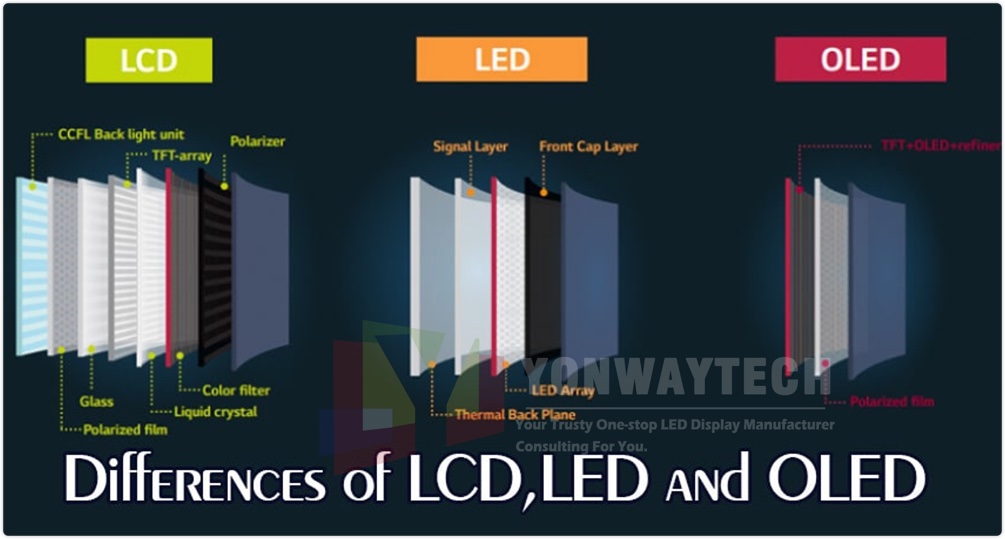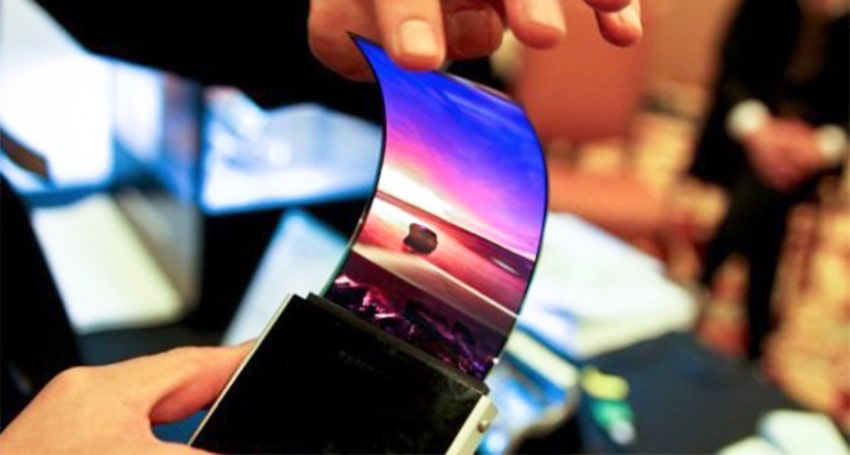Do you know what are the differences of LCD,LED and OLED?
The display screen is called one of the greatest inventions of the 20th century.
It is not too much. Our life is glorious because of its appearance.
With the development of science and technology, display screens are no longer limited to the application of TV screens.
Large-sized commercial LED displays screens begin to break into our lives, such as shopping malls, cinemas, it can be seen in various places such as indoor sports venues, and at this time, LCD, LED, OLED and other professional terms are also lingering in our ears, although many people talk about them, but most people know little about them.
So,what is the difference between Lcd、led and oled?

LCD, LED DISPLAYS And OLED
1, LCD
LCD is short for Liquid Crystal Display in English.
There are mainly TFT, UFB, TFD, STN and other types. Its structure includes plastic ball, glass ball, frame glue, glass substrate, upper polarizer, directional layer, liquid crystal, conductive ITO pattern, conduction point, IPO electrode and lower polarizer.
Taking LCD advertising screen as an example, it adopts the most well-known TFT-LCD, which is thin film transistor liquid crystal display. Its basic structure is to place liquid crystal box in two parallel glass substrates, set thin film transistor (namely TFT) on the lower substrate glass, set color filter on the upper substrate glass, the rotation direction of liquid crystal molecules is controlled by the signal and voltage changes on the thin film transistor, so as to achieve the display purpose by controlling whether the polarized light of each pixel is emitted or not.
The principle of liquid crystal display is that liquid crystal will present different light characteristics under the action of different voltages. The liquid crystal display screen is composed of many liquid crystal arrays. In the monochrome liquid crystal display screen, a liquid crystal is a pixel (the smallest unit that can be displayed on the computer screen), in the color liquid crystal display screen, each pixel consists of red, green and blue liquid crystals. At the same time, it can be considered that there is an 8-bit register behind each liquid crystal, and the value of the register determines the brightness of each of the three liquid crystal units, however, the value of the register does not directly drive the brightness of the three liquid crystal units, but is accessed through a “palette. It is unrealistic to equip each pixel with a physical register. In fact, only one line of registers is equipped. These registers are connected to each line of pixels in turn and loaded into the contents of this line, drive all pixel lines to display a complete picture.
2, LED SCREENS
LED is short for Light Emitting Diode. It is a kind of semiconductor diode, which can convert electric energy into light energy.
When electrons are compounded with holes, visible light can be radiated, so it can be used to make light emitting diodes. Like common diodes, light emitting diodes are composed of a pn junction and also have unidirectional conductivity.
Its principle when the positive voltage is added to the light emitting diode, the holes injected into the N area from the P area and the electrons injected into the P area from the N area, within a few microns near the PN junction, it is compounded with electrons in N region and holes in P region respectively to generate spontaneous emission fluorescence.
The energy states of electrons and holes in different semiconductor materials are different. When electrons and holes compound, the amount of energy released is different. The more energy released, the shorter the wavelength of the emitted light. Commonly used are diodes that emit red light, green light or yellow light.
LED is called Fourth generation Light Source, which has the characteristics of energy saving, environmental protection, safety, long service life, low power consumption, low heat, high brightness, waterproof, miniature, shockproof, easy dimming, concentrated light beam, simple maintenance, etc, it can be widely used in various fields such as indication, LED display, decoration, backlight, general lighting, etc.
For example, LED display screen, Advertising LED Screen,traffic signal lamp, automobile lamp, LCD backlight, household lighting and other lighting sources.

3, OLED
OLED is short for Organic Light-Emitting Diode. Also known as organic electric laser display, organic light emitting semiconductor.
This diode was discovered in the laboratory in 1979 by a Chinese American professor Deng Qingyun.
OLED consists of external OLED display unit and light emitting materials clamped in it, including cathode, emission layer, conductive layer, anode and base. Each OLED display unit can control to produce light of three different colors.
OLED display technology has the characteristic of self-luminous, using very thin organic material coating and glass substrate. When there is electric circulation, these organic materials will emit light, and the visual angle of OLED display screen is large, and can save power consumption. Since 2003, this display technology has been applied to MP3 music players.
Nowadays, a prominent representative of OLED application is the mobile phone screen. OLED screen can display perfect picture contrast, and the display picture will be more vivid and real. Due to the characteristics of liquid crystal, LCD screen does not support bending. In contrast, OLED can be made into curved screen.

Differences Among The Three
1, On the color gamut
OLED screen can display endless colors and is not affected by backlights,but LED Screen with better brightness and viewing angle.
Pixels have great advantages when displaying all-black images, at present, the color gamut of LCD screen is between 72 and 92 percent, while that of led screen is above 118 percent.
2, In terms of price
LED screens of the same size are more than twice as expensive as LCD screens in small pixel pitch led video wall, while OLED screens are more expensive.
3, In terms of mature technology of brightness and seamless.
LED screen is far better than LCD screen and OLED in brightness and seamless,especially in big size led video wall for advertising screen or indoor commercial digital signage use.
Whereas LCD or OLED for big size digital video wall which need spliced,the gap between panels will effects the performance and viewer feeling.
4, In terms of video performance and the angle of the display
The specific manifestation is that the visual angle of the LCD screen is very small, while the LED screen is satisfactory in layering and dynamic performance with the technology development of led display, in addition, the depth of the LED screen is well enough especially in YONWAYTECH narrow pixel pitch led display solution.









